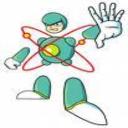Yahoo Answers is shutting down on May 4th, 2021 (Eastern Time) and the Yahoo Answers website is now in read-only mode. There will be no changes to other Yahoo properties or services, or your Yahoo account. You can find more information about the Yahoo Answers shutdown and how to download your data on this help page.
Trending News
A springboard diver intending to do a somersault brings her knees and arms closer to her body during the dive. What effect does this have?
This was a question on a test that I got wrong. My answer was "It increases her angular momentum." The other answers were A) It makes her fall more slowly B) It decreases her moment of inertia. and c) It decreases her angular velocity. I thought bringing in your arms and knees makes the rotation faster, which also makes the Angular momentum larger. Can someone please explain this problem to me.
5 Answers
- electron1Lv 73 years agoFavorite Answer
Angular momentum is conserved as she pulls her knees and arms closer to her body. This motion decreases her moment of inertia.
Angular momentum = Moment of inertia * Angular velocity
Since the angular momentum is constant, the angular velocity is inversely proportional to the momentum of inertia. You may wonder the energy comes from to increase her rotational kinetic energy. To pull her knees and arms closer to her body, she must exert a force on these parts of her body. The work that is done by this force increases her rotational kinetic energy.
- oubaasLv 73 years ago
angular momentum L = J*ω is conserved once the diver leaves the springboard
J1 decreases and ω1 increases such that J1*ω1 = J*ω
if, for instance, J1 = J/2, then ω1 = 2ω and J/2*2ω = J*ω as it has to be
- Anonymous3 years ago
The diver spins faster - yes. But that's because her moment of inertia (I) decreases and her angular momentum (L) remains constant.
L = Iω
ω = L/I (L is unchanged, I is reduced, so ω increases).
- Andrew SmithLv 73 years ago
Angular momentum is conserved once the diver has left the board.
What she can change is the MOMENT OF INERTIA.
From that the ANGULAR VELOCITY alters.
When the arms are brought close to the body the length of the rotating body reduces so the moment of inertia reduces and as the angular momentum must be conserved the angular velocity ( rate of spinning) increases.
Shortly before hitting the water and, when in the correct orientation, she stretches out. This increases the moment of inertia and effectively halts the spin ( not quite but near enough) so that she can gracefully enter the water without a splash.
Remember that the angular momentum is the PRODUCT of the moment of inertia by the angular velocity.
And that the moment of inertia for any mass at a distance x from the pivot is mx^2
so that halving x makes the moment of inertia 1/4 and the angular velocity 4 times greater.
- Dr. ZorroLv 73 years ago
If there is no external torque, the angular momentum cannot change. What happens is that the moment of inertia is less, so in order to maintain the same angular momentum, the angular speed needs to increase. In a formula:
L = I ω
For constant L, decreasing I increases ω.






